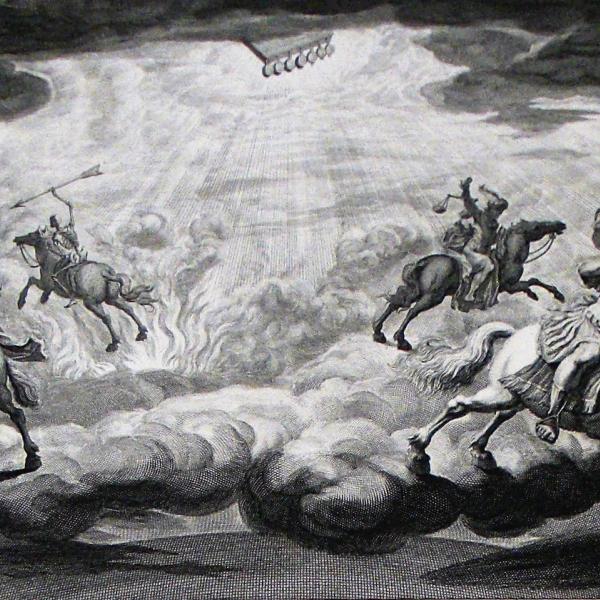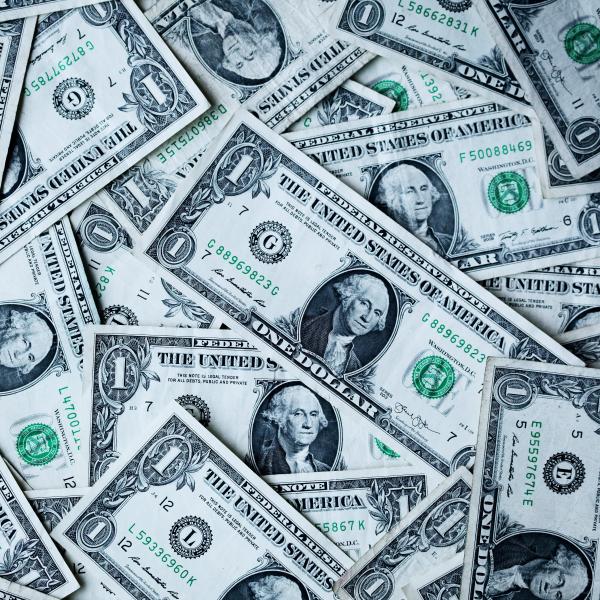Horror movies have been drawing audiences since the earliest days of film. But why are we drawn to fictional portrayals of events that we'd do anything to avoid in real life? And are we frightened by the same things we were 20 years ago? John Powers walks us through the history of the horror film. From the Frankenstein and Nosferatu to Freddy Krueger and Bruce Campbell, we break down what makes us scream.
Transcript
Rebecca King (Host): Hey there listeners. Thanks for tuning in to Hold That Thought. I’m Rebecca King, and in honor of Halloween this year, we’re looking at horror movies. Personally, I must admit that I can’t stomach slasher films and generally don’t like being scared. So the appeal of horror movies kind of baffles me. Luckily, I have John Powers with me today. Powers is a lecturer in Film and Media Studies at Washington University in St. Louis, and is currently teaching a course on Horror Across Media. Today we’ll discuss the appeal of horror film and how the genre has changed over time.
So let’s jump in with the biggest question. The paradox of horror. Why are we drawn to these horrific fictional events, when in real life, we would do anything to avoid them?
John Powers (guest): And so we sort of approach it from two different perspectives: The first is from the tradition of analytic philosophy where basically we're compelled by our own curiosity and especially our own curiosity about things that are unknowable, that are monstrous... things that we don't have opportunities to encounter in our daily lives. And especially when those monstrous, horrific, frightening things are embedded within narrative structures, which then sort of mobilize them and so we're interested not only in that which is unknowable but also all of the normal non-rational processes that happen with any media where we're trying to follow a narrative. There are questions posed, we form hypotheses, etc. So we look at that but then we also look at another framework that's a little bit less philosophically determined and a little more cultural. So the logic to the second one would be that horror allows us to confront social and cultural taboos in a way that we can't in our daily lives by making them monstrous, by making them horrific, by actually giving voice to borrow from psychoanalysis that which has been repressed. Horror provides a kind of outlet for this. And so that's when the students and I can get into questions of gender and questions of race and questions of sexuality and all of these things that horror films seemed to address but then make terrifying for us in some way or another
RK: So if we’re to look back at the horror movie genre, where do we start? The 1922 silent German film Nosferatu, which was an unauthorized adaptation of Bram Stoker’s Dracula, comes to mind.
JP: Identifying first in film history is always a little difficult. Nosferatu is an example of what's called German expressionism, which was a movement in Germany in the 1920s, not just in horror. There's a wide variety of subject matter but often horrific or supernatural or fantastic events depicted in those films. And so The Cabinet of Dr. Caligari is sort of the first major German expressionist film. Nosferatu is definitely not the first horror film, but certainly it's an important and influential one especially in terms of its influence on what's called the Universal Horror Cycle of the 1930s which is when Universal Studios developed a series of horror films that were popular. These are the films that people know with Boris Karloff and Bela Lugosi and Dracula and Frankenstein and The Mummy and all of these adaptations of Poe's stories like The Black Cat and The Murders in the Rue Morgue and things like that.
RK: This reliance on Gothic horror continued through the 40s before turning to more doomsday films like Godzilla in 1954 or merging science fiction themes with horror in the wake of the world’s first brush with nuclear war in WWII. And though the horror genre goes through some rather drastic changes subsequently in the 60s, the legacy of the Gothic monsters and their archetypes can still be felt in the horror film genre, says Powers.
JP: There's this sort of terrible trio that are derived from Gothic literature that can make their way into film and that's Dracula, Frankenstein, and Dr. Jekyll and Mr. Hyde. These I think are pillars because even apart from the many different instantiations of the vampire or the mad scientist gone amok, they provide certain archetypes that play out even in horror films that's not explicit adaptations of those stories. So Frankenstein is sort of the cautionary tale about playing God and about overreaching and exceeding your bounds and then creating something that you can't control. Dracula on the other hand is a seducer. And there you get sexuality very much intermixed with the horrific and the idea that the thing that terrifies or repels us is also seductive in many ways to us...it's something that we don't want to experience but yet can't seem to help wanting to experience. And then the Jekyll and Hyde thing is about the duality of horror, about how these placid exteriors can harbor these very dark interiors and that there are these competing, animalistic sides of us that unhinged from social convention may do some of these awful dark things that we experience in horror but for the fact that we're kept in check by this other side. And so those three stories I think are pillars in the sense that they provide the archetypes or ideas or paradigms that sort of get permuted across different narratives different forms of the genre.
RK: The Jekyll and Hyde archetype certainly comes to mind when we move on to one of the biggest turning points in the horror genre with Alfred Hitchcock’s 1960 movie Psycho.
JP: I think there's a couple of important shifts that start to solidify in the 60s especially around the movie Psycho and things like that. And a couple of the major ones are that the idea of the monster shifts from being something that's supernatural in origin or something that we would understand as other in a very obvious way to being someone who is recognizably human who's good looking, like the boy next door but actually he's harboring some kind of deep psychological kind of psycho-sexual urges that then prompt him to do these horrific things. And the other issue that comes up in Psycho and then in more horror films in this era is that you start having more complex shifts in terms of point of view: Whose point of view are we aligned with? And how do we identify? Do we identify with the victim or with the killer and what are the stylistic techniques that filmmakers use to depict point of view and the way that identification shifts? That becomes really important. And the slasher movies come along and you have a lot of psychoanalytic and feminist theorists who have some sophisticated arguments about the way that viewer identification shifts across genders over the course of a film.
RK: Psycho really opened the doorway to 70’s and 80’s slasher horror movies like The Texas Chainsaw Massacre in 1974, Halloween in 1978, and A Nightmare on Elm Street in 1984 to name a few. At same time, a slew of demonic and psychological horror movies such as Rosemary’s Baby and The Night of the Living Dead in 1968, The Exorcist in 1973, The Shining in 1980, and Poltergeist in 1982 carry on the occult legacy of early horror, but shift to reflect the issues and fears of the contemporary audiences. But these movies seem a far cry from the Universal Cycle. Had what scared audiences changed so much in a generation?
JP: So very few people I think would disagree with the fact that the things that we are scared of are socially and culturally determined. And certainly horror films do seem to tap into social, political, and cultural currents and have historically been vehicles for addressing that which is topical. The question is how much do you want to appeal to what we might call a kind of Zeitgeist explanation for what scares us? And what is the process by which these sort of very broad cultural strands make their way into specific films which are creative endeavors full of rational decision making by practitioners and is there something that sort of mediates between between those levels?
RK: As an example of how horror films tap into these currents, Professor Powers shares how he and his students look at the slasher film The Texas Chainsaw Massacre.
JP: We provide a lot of deep background on the 60s and the 70s. We talk about the counterculture and the Manson family's connection to the counterculture. And there's a character in The Texas Chainsaw Massacre who clearly is supposed to remind us of Charles Manson. He resembles Manson in the way... there's ideas about the family, against a backdrop of changing social and sexual mores. There's a lot of stuff in there about the working class and you know, they're in a rural area in Texas and there's this family who is sort of slaughtering people and cooking them and they're selling the barbecue at the gas station and they have this house of horrors. But you learn in the course of the film that actually they're slaughterhouse workers who have been laid off from their jobs at the slaughterhouse because they've been made obsolete by technology and there are debates in the film about the best way to kill. Like do you use a sledgehammer to kill the cattle? Or do you use the bolt gun? But the sledgehammer is better because their jobs don't go away when you use the sledge hammer... So all of this stuff gets kind of woven into that film and so we do talk about things like, "how does this seem to express certain fears about the working class, about technology, industry, etc.?" and that kind of thing. So yes, we definitely look at how some of this cultural stuff makes its way into horror films.
RK: And in response to the proliferation of gory horror movies in the 60s, 70s, and 80s, filmmakers began to make horror-comedies to make fun of the genre’s tropes. Most notably, Sam Rami’s The Evil Dead in 1980 which has become a cult classic. But according to John Powers, comedy and horror actually goes back to the genre’s early days.
JP: My students and I were just looking at the original version of Frankenstein, the 1931 version, where Frankenstein's father is this comic relief in a way that really sticks out to contemporary viewers as this sort of strange attempt at comic relief in the middle of Frankenstein but certainly with The Evil Dead and Re-Animator, [and] Cabin in the Woods. Those two seemingly disparate genres come together and I think a horror has encouraged and accommodated a very rabid and active fan base that is interested not just in the terrifying and scary aspects of horror, but also finds a certain camp value in it and laughs at the most outrageous kills in Friday the 13th sequels and tap into some of these more comedic or campy midnight movie associations. We'll look for instance when we'll look at The Evil Dead, they'll read a little bit about Bruce Campbell who has become sort of a cult film icon for the horror comedy. A lot of those films have a kind of meta-component where The Cabin in the Woods and even Scream and things like that are very aware of the conventions of horror. And so part of the comedy derives from the fact that they are very self-conscious and self-aware about everything that's come before and what you are supposed to do and aren't supposed to do.
RK: In the late 90s and early 2000s, while American film companies continued to put out sequels to tired slasher franchises, Asian horror movies also took the world by storm for their fresh approach to the genre, says Professor Powers.
JP: There's always been a very rich tradition of horror in Japan. There are a lot of very famous Japanese ghost movies from the 60s like Kwaidan and things like that. And then there was this so-called J-horror phenomenon that started to coalesce in the 90s and then in the early 2000s achieved international recognition. Those films seemed to be exciting at least to American audiences or international audiences because they were sort of clued in about new media and technology and films like Ringu and Pulse sort of made use of the Internet and new media. And those films were a little bit I think more subtle than some of the horror because you also realized that they came along. The slasher genre really dominated the 80s and I think by the 90s, even though the slasher films that we were getting started to seem a little stale like I Know What You Did Last Summer just didn't quite have the appeal. And a lot of the franchises that had been built around the slasher icons like the Freddy and the Jason and Michael Meyers stuff were in this thing where they had really seemed like they had run out of gas and that even though they kept making one every couple of years, they did not hold whatever appeal the originals had or they had become very tired in the way that they tried to scare people and so not only do you have something like The Blair Witch Project in 1999 which tried to restore the psychological to horror, but then when J-horror came along, the scares are different in those movies.
RK: Today’s most popular subgenre of horror seems to be zombie horror with the success of the 28 Days Later franchise, Zombieland, the comicbook and television series The Walking Dead, and even Pride and Prejudice and Zombies. Who knows where the genre will take us next. The horror film genre has changed so much since Boris Karloff and Bela Lugosi. I had to ask Professor John Powers if, with all his knowledge of horror films, he thought what we as humans feared had changed over time as well.
JP: I think if you abstract the question enough or if I guess you go to the outermost level, there are probably continuities. I think that we fear death. And I think especially we fear what Steven King calls the bad death, not just that you die but that you die in a way that allows you time to contemplate just how terrible your own death and how painful your own death will be. I think that we are probably still afraid of that which is "other" in some way...the things that we don't understand and can't immediately rationalize or admit into our purview or our worldview and whatever form that takes, a horror seems to be about confronting those things.
RK: Many thanks to John Powers, a lecturer in Film and Media Studies at Washington University in St. Louis, for taking the time to talk about the horror film genre with me. And thanks to all of you too for tuning in to Hold That Thought! Did we leave out your favorite horror movie in our podcast today? Let us know where you think it fits in on Facebook or Twitter. And I hope you all have a spooky and fun Halloween!
Credits:
"Exorcist" soundtrack, monster theme, Dracula soundtrack, Psycho soundtrack, Halloween Sondtrack, Carrie sountrack, Reanimator soundtrack, and the Ring soundtrack




